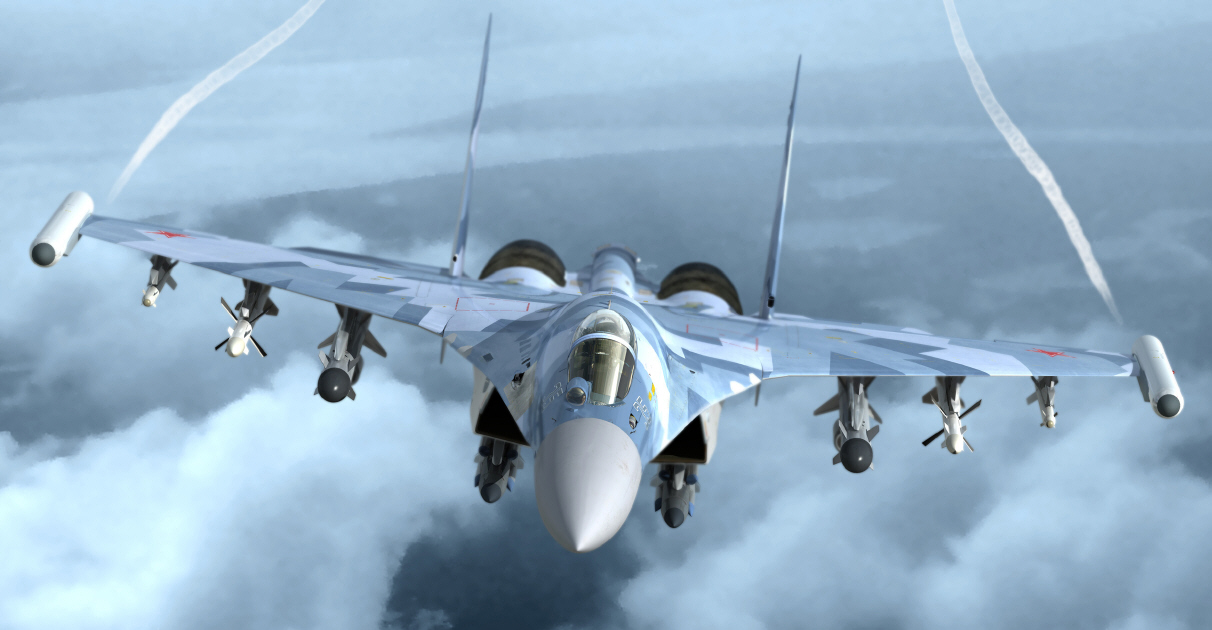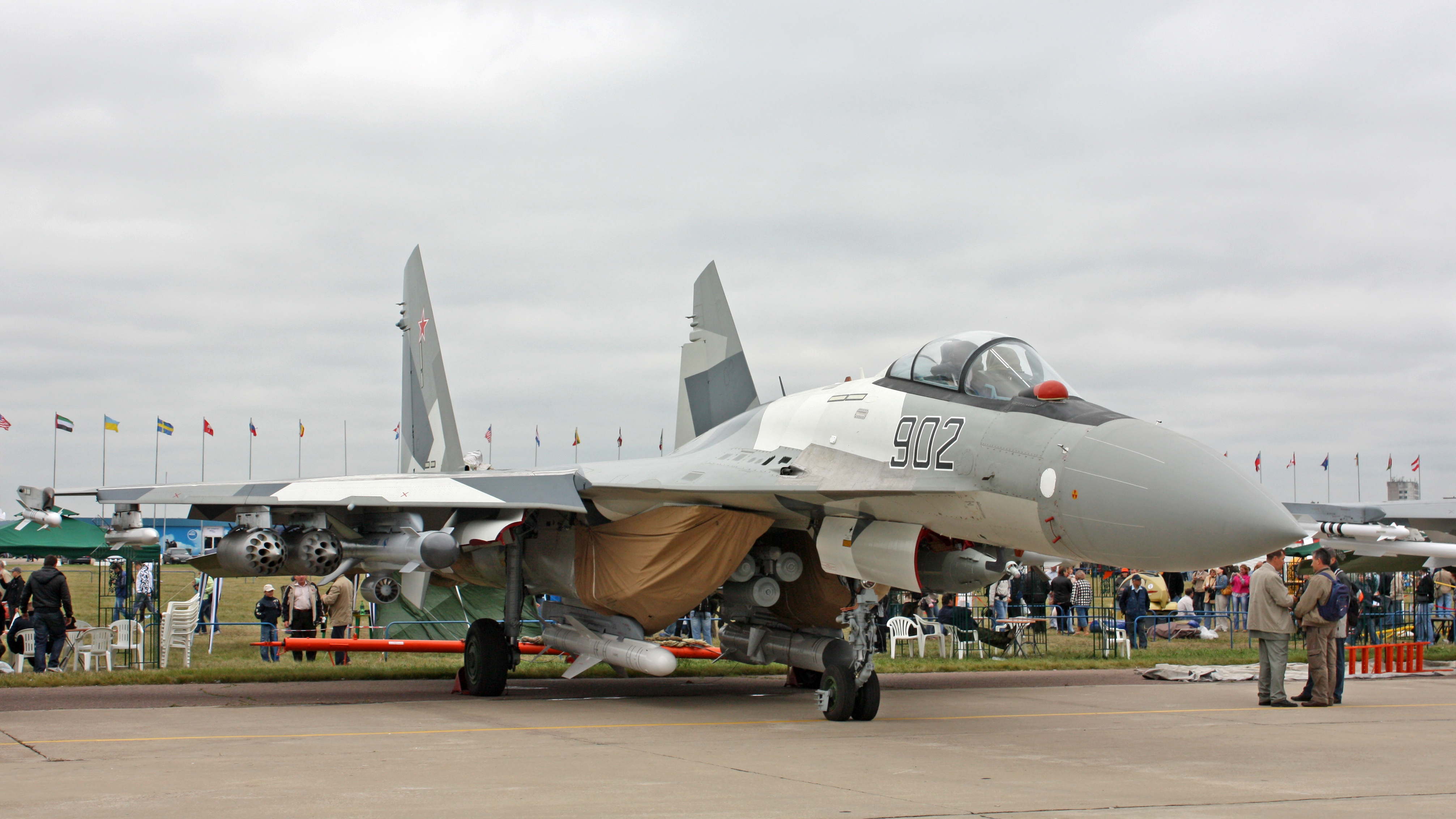هنا مزيد من القاء الضوء على ماحدث في Cope India
منقول كما هو بالكامل ( مع ملاحظة ان شلّة الهنود كانت مكونة من : الميراج 2000 , الميج 27 , السوخوي MKI , الجاغوار , وكذلك العتيقة ميج 21 التي تم تحديثها للاشتقاق بايسون )
الطريف هنا انه يقال - والذمة على الراوي - ان الميج 21 اعطت الايجل دروسا في عدم الاستهانة بالجدّات العتيقات ( خصوصا المزودات بصواريخ الأدر المكافئة لنظيرتها الامريكية AIM-120 ) >>> انا من هذه الجملة
Indian Air Force flying the MiG-21 'Bison' gave USAF F-15 drivers - a very bad day احسست ان الميج 21 هزمت الايجل بشكل دراماتيكي .. والله اعلم
Starting in 2004 the joint Cope India exercise began over South Asia after an absence of nearly 40 years, pitting F-15Cs of the USAF against a mix of older and newer Indian Air Force (IAF): Mirage 2000, MiG-21, MiG-27,
SU-30Mk and Jaguar aircraft.
However this is where everyones expectations ceased.
By every available account: the IAF
soundly defeated American F-15Cs over and over and over.
 [Above] Note USAF F-15Cs and IAF Mirage 2000s operating with drop-tanks, while the IAF Su-30Mks - do not.
[Above] Note USAF F-15Cs and IAF Mirage 2000s operating with drop-tanks, while the IAF Su-30Mks - do not.
American officials credited Indian pilots with being:
"
very proficient in [their] aircraft and smart on tactics. That combination was tough for us to overcome,"
"The adversaries are better than we thought," Col. Mike Snodgrass added.” And in the case of the Indian Air Force both their training and some of their equipment was better than we anticipated."
"The Indians flew a number of different fighters, including the French-made Mirage 2000 and the Russian-made MiG-27 and MiG-29, but the two most formidable IAF aircraft proved to be the MIG-21 Bison, an upgraded version of the Russian-made baseline MiG-21, and the Su-30MK Flanker, also made in Russia."
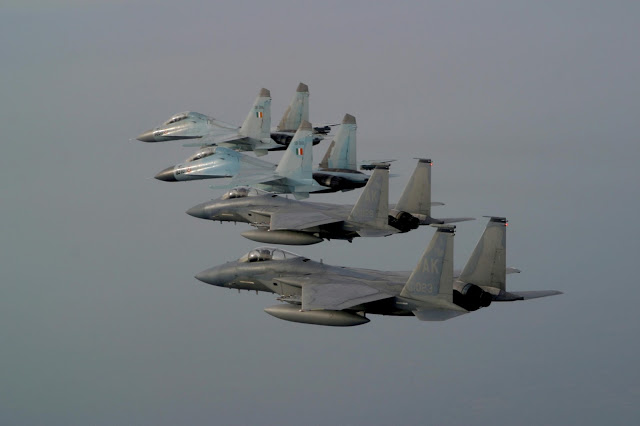
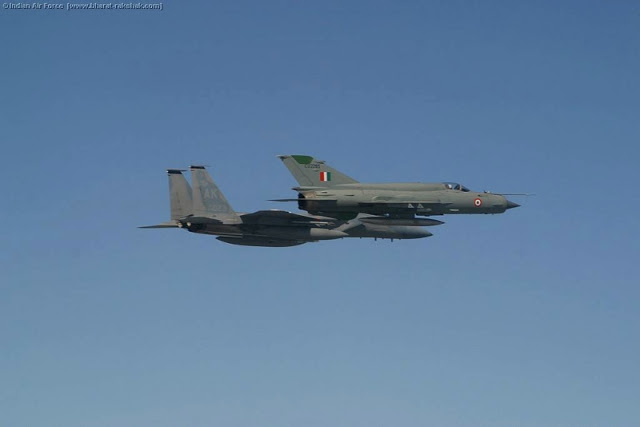
When questioned on the capabilities of IAF pilots, Col Greg Newbech, USAF Team Leader made the following remarks:
“What we’ve seen in the last two weeks is the IAF can stand toe-to-toe with best AF in the world.”
“I pity the pilot who has to face the IAF and chances the day to underestimate him; because he won’t be going home.”
“The greatest compliment we heard from an IAF pilot – You American pilots are just like us, simply down to earth people.”

When word of the Cope India 2004 results reached Washington DC, it caused an uproar. Some Western military observers quickly attempted to dismiss/reframe the results, claiming that USAF did not bring its true ‘go-to-war-gear’ to these exercises.
True, American USAF F-15C’s typically were outnumbered 3-to-1. However most of these explanations have dubious merit:
1.)
AIM-120 AMRAAM missile and
AESA radars would have made little difference in BVR - as new jamming technologies (like
DFRM) degrade or negate most of these (radio EM-spectrum) AIM-120 class capabilities - regardless. In one sense: active-homing (
fire-and-forget) BVR class weapons have become increasingly ‘easier’ to elude - using DRFM-class deception techniques. Indeed this might be what effectively occurs during 'Red Flag' 2008, (so keep reading.)
2.) It is unclear which R-27 missile round was employed by the IAF in 2004: IR-homing (R-27T), semi-active radar homing (R-27R) or active radar homing (R-27AE). Had the latest fire-and-forget class been allowed, the IAF would have simply used their R-77 similar to the American AIM-120 round. R-77 also has an IR-homing version - so again - another “wash.”
3.) Russian
Flanker was designed to counter and defeat F-14, F-15, F-16, F-18 series. Its no surprise experienced Indian aircrews might prevail.
4.) Indians only used the Su-30 "MK" not their Su-30 "MKi." Reportedly IAF Flankers simply used their larger radar and longer range weapons to fire on the F-15C before USAF fighters could fire back.
5.) Lastly the American military always fight its wars over hostile airspace: so USAF-to-IAF numbers/odds/environment is 150% applicable.
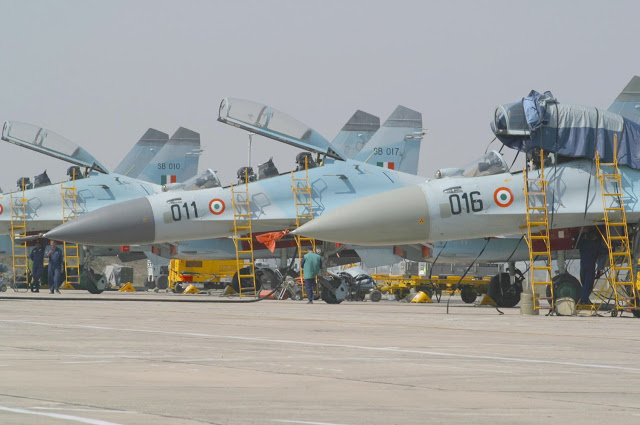
Best link author could locate on Cope India:
http://www.indiadefence.com/COPE.htm
Subsequent Cope India exercises in 2005, 2006 had little to no information coming out. Judging from the hubris displayed by the USAF in 2008 – the silence from the USAF during the 2005 and 2006 Gwalior exercises – was deafening...
 - Now - jump to the 2008 Nellis AFB ‘Red Flag’ exercises hosted by the USAF -
- Now - jump to the 2008 Nellis AFB ‘Red Flag’ exercises hosted by the USAF -
This time the Indian Air Force bring their new Su-30 MKi.
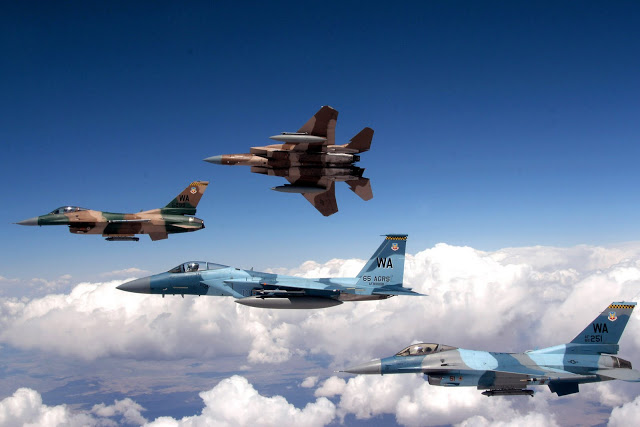 64th and 65th Aggressor squadrons at Nellis AFB, Nev.
64th and 65th Aggressor squadrons at Nellis AFB, Nev.
Colonel Terrence Fornof, Director of the Requirements and Testing office (USAF Warfare Center, Nellis AFB), was providing a briefing to a number of retired US generals, [video has in the past appeared, been removed, and then reappeared]:
Listen to a pod-cast audio regarding the same presentation (even MORE interesting) * note: this pod-cast with the editor "Flight" appears to have been pulled. The thrust of the interview was that Nellis instructors in the F-15 were able to catch the F-22A in a turn:
http://iagblog.podomatic.com/player/web/2008-11-05T15_41_04-08_00
This means that according to the Colonels own hand positions - a properly flown Su-30 can (also) catch an F-22 in a turn. So what - actually - is the USAF trying to say?...
It says nothing.
The US Colonels remarks caused an international flap in India. Did some in the USAF have something to prove?
 Indian Su-30MKi landing at Nellis AFB, Nev. in 2008
Indian Su-30MKi landing at Nellis AFB, Nev. in 2008
Problem is Colonel Fornof comments produced more questions than answers:
a.) Indian MiG-21IBis (I-Bis) "Bison" are equipped with Russian-made Kopyo radars, not Israeli “F-16” radars.
b.) Two conflicting accounts on what exactly happened at Mountain Home AFB both agree Fornof is in error. The first is 1-v-1 DACT at Mountain Home AFBT never occurred. The second was the kill ratio at Mountain Home was so overwhelmingly in favor of the IAF flown Russian-built fighter that the Sukhoi was considered effectively unbeatable. There is almost zero chance the Americans will entertain allowing this information out.
c.) FOD concerns are not unusual for any air force operating halfway around the world. The Flanker has simply immense loiter and combat persistence ability – take-off (fighter scramble) intervals are not (as) critical for Flanker - as for shorter range aircraft.
d.) MKi use Lyulka AL-31 turbofans, not Tumansky powerplants as USAF officer stated.
e) F-15C and other USAF fighters had the same number of blue-blue 'fratricide' as the IAF and in addition the American were all networked with each other.
f) MKi did not use thrust vector mode during the Nellis AFB exercises and only sparingly at Mountain Home.
g) Watching video of Su-30 maneuvering - anyone can see the Americans have simply been outclassed by a significant margin.
[Below] . "Low-tech" aircraft fitted with the right equipment, and properly trained crews - should never be underestimated. It appears the IAF knows exactly what they are doing.
Indian Air Force MiG-21IBis (I-Bis). The paradigm(s) after 1982 Bekaa Valley and 1991 Gulf War - appear to have been misguided.
 Indian MiG-21-IBis with R-77 "Adder" missile round. The R-77 is the equivalent to the American AIM-120.
It is important to remember some historical context here. Everyone (everyone) wanted ACM training from the Indians after they soundly defeated Pakistani F-104s with MiG-21s during the Indo-Pakistani war in 1971. Indian MiG-21s downed F-104s with no MiG losses to Starfighters. So under actual combat conditions the Indians do have a history of air-combat proficiency. Plus lets be honest – the Flanker is probably the best ACM fighter in the world - in the last 70 years.
Indian MiG-21-IBis with R-77 "Adder" missile round. The R-77 is the equivalent to the American AIM-120.
It is important to remember some historical context here. Everyone (everyone) wanted ACM training from the Indians after they soundly defeated Pakistani F-104s with MiG-21s during the Indo-Pakistani war in 1971. Indian MiG-21s downed F-104s with no MiG losses to Starfighters. So under actual combat conditions the Indians do have a history of air-combat proficiency. Plus lets be honest – the Flanker is probably the best ACM fighter in the world - in the last 70 years.
So what other conclusions if any, can be drawn?
- The paradigms established/embraced after Bekaa Valley ‘Turkey Shoot’ in 1982 and the results of the 1991 Gulf War appear to have been misguided by 2004 - due to Indian MiG-21IBis (I-Bis) versus the F-15 Eagle.
- There is no substitute for flight hours and training. Proper training allows aircrews (of any air force) to extract the maximum performance out of their aircraft.
- A similar post-stall counter-tactic was used by Nellis (F-15) instructors against less-experienced aircrews in both F-22 and Su-30. So by definition: a properly flown Su-30 also can catch F-22 in a turn.
- Remarking on F-22 needing ‘more missiles’ - is consistent with F-22 having only two IR missile rounds, historical air-to-air missiles hit probabilities and Raptors lack of helmet sighting. Su-30 brings helmet-sighting, nearly twice the number of missile rounds, IRST, and a huge fuel reserves - at much (much) lower costs (and so in larger numbers?)- to the fight.
- His remarks on the inability of USAF instructor aircraft to employ their AIM-120 AMRAAM round - is interesting. Whether it was jamming, snooping, heads-up defensive flying, or other tactical issues, his comments are (duly) noted.
- Remarks on the Indian MiG-21 are revealing. During the Bekaa Valley (Lebanon) air battles of June 1982, Israeli F-15 and F-16 radars had no trouble seeing (and downing scores of) Mig-21s. So DRFM-class jammers even on a MiG-21 - may have pushed BVR off the table - for any radio-spectrum AIM-120 equipped fighter - even Raptor?
- Colonel Fornof was referring to this video (F-22 and Su-30 side-by-side):
[The video has disappeared - again. We will attempt to find a copy] Looking at the video, an astute observer noting airspeed, afterburner usage, altitude-loss, energy-recovery and aircraft attitude during/between maneuvers: can see that both F-22 and Flanker evenly matched regardless of Colonel Fornof statements or hand position(s). For now this video gives some idea:
Some believe as (or if?) the F-22A flight control system evolves - its maneuverability should increase - however look at what we dealing with here [see below]. This level of agility for a 20+ ton aircraft - is simply unprecedented. Remember F-22A lacks the pilot helmet-sighting of the Sukhoi. No matter how you rationalize it - the USAF and her F-22A Raptor fleet - is in huge trouble.
Indian News Report of2008 Red Flag:
The Sukhoi is going to be with us for quite awhile, and by any measure, is (and will be) a nightmare for USAF/USN brass, planners and aircrews alike. Flanker has unrefueled loiter and combat persistence ability -
that has no western equivalent.
Train how you fight and fight how you train, train and train.
The question may be who fights over friendly airspace and who fights of hostile airspace?
 We count no less than 12 hard points on this MKi: four on each wing, one on each engine nacelle, and two on the aircrafts centerline. Even without external drop tanks, Flanker unrefueled endurance and combat radius remains unequaled in the world.
We count no less than 12 hard points on this MKi: four on each wing, one on each engine nacelle, and two on the aircrafts centerline. Even without external drop tanks, Flanker unrefueled endurance and combat radius remains unequaled in the world.
Multi-sensor Advanced-Flanker with pilots of equal skill - is more (more) than a match for F-22.
When or if the
Lockheed-Martin F-22 Raptor participates in a future Cope India exercise at Gwalior India, whatever the results, they are certain to be quite the revelation - even if we never officially hear about them.
Conversely, we firmly conclude that procuring additional F-22s for the USAF will not resolve anything of this. One can purchase between three (3) and seven (7) Advanced Flanker for the cost of a single (1) F-22. To put it another way: if four (4) F-22 Raptors fly against twelve (12) to twenty-eight (28) Advanced Flankers - none (none) of the F-22s can survive this engagement. F-22 is simply far (far) too expensive for a real world.
India has placed a fresh order for forty (40) more Sukhoi aircraft with Russia.
http://www.flightglobal.com/blogs/the-dewline/2008/11/a-final-word-from-india-on-you/
والذمة على الراوي
http://theboresight.blogspot.ae/2009/07/swirl-of-controversy-cope-india-and-red.html
لكن تبقى الايجل مقاتلة متميزة ونضجت بشكل كافي لاثارة اعجابي ( خاصة في احدث اشتقاقاتها ) مع تحفظي المعتاد على بصماتها المرتفعة .
اثارت اعجابي عندما ركبوا في انفها الـ OSF ( بدل الـ Tiger Eye المركب اسفل البدن والمحدود في زاوية الرؤية العلوية ) .. وكذلك فعلت عندما اضافوا لها نظام Fly By Wire , ايسا ونظام حرب الكترونية حديثين , تفعيل نقاط حمولة اضافية ..
هي حاليا معروضة على الامارات ( لمن يتحدث عن العنب والحامض الذي لا يطال )

معروضة باشتقاق السايلنت ايجل في سنة 2011 ...
كما سبق وعرضت في تسعينيات القرن الماضي بالاشتقاق F-15 U الخاص بالامارات والذي رفضته رسميا ...
top Boeing executive has added a new piece to the UAE's fighter modernisation puzzle, saying that the US government has delivered classified briefings about the capabilities of the F/A-18E/F Super Hornet and the F-15E Strike Eagle.
في مرحلة التحديث الحالية , قامت الحكومة الامريكية باعطاء الامارات معلومات سرية عن قدرات اف18 اي /اف سوبر هورنيت و اف 15 اي سترايك ايجل .
وكذلك جرى الاهتمام بمقاتلة الجيل الخامس :
On 12 November, the UAE air force announced plans to acquire a "next generation fighter" in the 2018-2025 timeframe.
The Lockheed Martin F-35 joint strike fighter (JSF) has been previously named by the UAE as a potential acquisition target. But
briefing requests may indicate that the F/A-18E/F and the F-15 Silent Eagle are also in the discussion, Kohler said. With the exception of all-aspect very low observability, or stealth, the F-15SE and F/A-18E/F international roadmap variant share many of the same sensor, avionics and weapons capabilities with the F-35.
"I think [UAE officials] would be interested, depending on exactly what they want," Kohler said.
http://www.flightglobal.com/news/ar...18-into-uae-fighter-modernisation-mix-364787/
هنا بعض المعلومات التثقيفية لاخوتنا حديثي العهد بالمنتدى
ماهو طراز f15 u الذي عرض على الامارات العربية المتحدة قديما ؟
http://defense-arab.com/vb/threads/63169/
****************
الموضوع بالمختصر : اختيار افضل القدرات الموجودة ودمجها بعد التجربة والبرهان ... مؤخرا ... نضجت الايجل بشكل يجذب الاهتمام ,,, لكن على بوينج باعتقادي الاهتمام بالبصمات المختلفة ( انجاز السايلنت ايجل .. ليس كنموذج عرض ولكن كمنتج جاهز للانتاج ) كما تعرض الآن الاف 18 كخيار ترقية جاهز بطريقة ADD-on Kit لمشغلي الاف 18 العالميين او حتى الجدد .



















